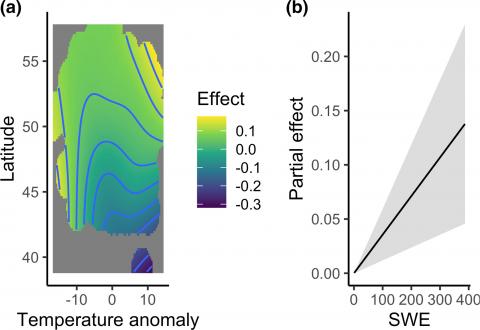In migratory birds, among- and within-species heterogeneity in response to climate change may be attributed to differences in migration distance and environmental cues that affect timing of arrival at breeding grounds. We used eBird observations and a within-species comparative approach to examine whether migration distance (with latitude as a proxy) and weather predictors can explain spring arrival dates at the breeding site in a raptor species with a widespread distribution and diverse migration strategies, the American Kestrel Falco sparverius. We found an interactive effect between latitude and spring minimum temperatures on arrival dates, whereby at lower latitudes (short-distance migrants) American Kestrels arrived earlier in warmer springs and later in colder springs, but American Kestrels at higher latitudes (long-distance migrants) showed no association between arrival time and spring temperatures. Increased snow cover delayed arrival at all latitudes. Our results support the hypothesis that short-distance migrants are better able to respond to conditions on the breeding ground than are long-distance migrants, suggesting that long-distance migrants may be more vulnerable to shifts in spring conditions that could lead to phenological mismatch between peak resources and nesting.
The interaction between minimum temperature anomaly in March and April and latitude on spring arrival dates of American Kestrels in North America, 2002–2018. (a) At lower latitudes, American Kestrels arrived earlier after a warmer spring and later after a colder spring. At higher latitudes, American Kestrels arrived at the same time regardless of spring minimum temperature anomaly conditions. (b) Partial effect of snow-water equivalent (SWE) on spring arrival dates of American Kestrels in North America, 2002–2018. American Kestrels arrived later if there was more SWE in March.
| GEM3 author(s) | |
| Year published |
2021
|
| Journal |
IBIS
|
| DOI/URL | |
| GEM3 component |
Modeling
|
| Mentions grant |
Yes
|

